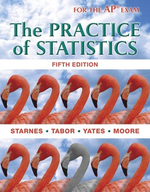Solution Found!
Solved: Exercises 35 to 38 involve a special type of density curve one that takes
Chapter 2, Problem 35(choose chapter or problem)
Involve a special type of density curve - one that takes constant height (looks like a horizontal line) over some interval of values. This density curve describes a variable whose values are distributed evenly (uniformly) over some interval of values. We say that such a variable has a uniform distribution.
Accidents on a level, 3-mile bike path occur uniformly along the length of the path. The figure below displays the density curve that describes the uniform distribution of accidents.
(a) Explain why this curve satisfies the two requirements for a density curve.
(b) The proportion of accidents that occur in the first mile of the path is the area under the density curve between 0 miles and 1 mile. What is this area?
(c) Sue’s property adjoins the bike path between the 0.8 mile mark and the 1.1 mile mark. What proportion of accidents happen in front of Sue’s property? Explain.
Questions & Answers
QUESTION:
Involve a special type of density curve - one that takes constant height (looks like a horizontal line) over some interval of values. This density curve describes a variable whose values are distributed evenly (uniformly) over some interval of values. We say that such a variable has a uniform distribution.
Accidents on a level, 3-mile bike path occur uniformly along the length of the path. The figure below displays the density curve that describes the uniform distribution of accidents.
(a) Explain why this curve satisfies the two requirements for a density curve.
(b) The proportion of accidents that occur in the first mile of the path is the area under the density curve between 0 miles and 1 mile. What is this area?
(c) Sue’s property adjoins the bike path between the 0.8 mile mark and the 1.1 mile mark. What proportion of accidents happen in front of Sue’s property? Explain.
ANSWER:Step 1 of 5
Using the figure which shows the density curve that describes the uniform distribution of accidents, we can determine the following:
